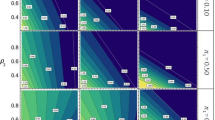Summary
The value of marker-assisted selection (MAS) using linkage disequilibrium between genetic markers and quantitative trait loci (QTL) was examined. To simulate the disequilibrium, four base populations were created, F2, F5, F10 and F20, by random mating from a cross between two inbred lines. Selections were on breeding values estimated from: (1) marker QTL (MQTL) associations (MAS); (2) conventional best linear unbiased prediction (BLUP) methods; and (3) a combination of 1 and 2 (COMB). Alternative cases were studied by varying the parameters (heritability, initial linkage disequilibrium, and distribution of QTL effects). A genome with 100 QTL and 100 markers randomly (but equally) spread over 20 chromosomes, each 100 centiMorgans (cM) in length, was generated. Linkage disequilibrium (over 30 replicates) of QTLs with their nearest marker averaged 0.153, 0.104, 0.068, and 0.047 for the four base populations, and fell to 0.035, 0.025, 0.021, and 0.018, respectively, after ten generations of MAS selection (heritability 0.25). The initial linkage disequilibrium had the greatest effect on the genetic gain by MAS with the responses for the base populations F2>F5>F10>F20. Genetic gains by conventional BLUP selection were usually greater than by MAS. However, MAS contributed to the combined selection (COMB) to give appreciably higher genetic responses. Hybridization of selected lines after several generations of selection contributed little to generating further linkage disequilibrium. Detection of markers closer to the QTL will increase the linkage disequilibrium available for selection. Eventually with very close linkage each QTL allele can be uniquely identified in selection, and selection will then be equivalent to selection on the QTLs themselves.
Similar content being viewed by others
References
Beckmann JS, Soller M (1983) Restriction fragment length polymorphisms in genetic improvement: methodologies, mapping and costs. Theor Appl Genet 67:35–43
Dekkers JCM, Dentine MR (1991) Quantitative genetic variation associated with chromosomal markers in segregating populations. Theor Appl Genet 81:212–220
Falconer DS (1989) Introduction to quantitative genetics, 3rd edn. Longman, Harlow, UK, p 19
Fernando RL (1990) Statistical problems in marker assisted selection for QTL. In: Proc 4th World Congr Genet Appl Livestock Prod 13:433–436
Fernando RL, Grossman M (1989) Marker assisted selection using best linear unbiased prediction. Genet Sel Evol 21: 467–477
Georges M, Massey JM (1991) Velogenetics, or the synergistic use of marker assisted selection and germ line manipulation. Theriogenology 35:151–159
Goddard ME (1992) A mixed model for analyses of data on multiple genetic markers. Theor Appl Genet 83:878–886
Haldane JBS (1919) The combination of linkage values and the calculation of distance between loci of linked factors. J Genet 8:299–309
Kashi Y, Hallerman E, Soller M (1990) Marker assisted selection of candidate bulls for progeny testing programmes. Anim Prod 51:63–74
Kennedy BW, Sorensen DA (1988) Properties of mixed model methods for prediction of genetic merit. In: Weir BS, Eisen EJ, Goodman MM, Namkoong G (eds) Quantitative genetics. Sinauer, MA, pp 91–103
Lande R, Thompson R (1990) Efficiency of marker assisted selection in the improvement of quantitative traits. Genetics 124:743–756
Quaas RL, Pollak EJ (1980) Mixed model methodology for farm and ranch beef cattle testing programs. J Anim Sci 51:1277–1287
Smith C (1967) Improvement of metric traits through specific genetic loci. Anim Prod 9:349–358
Smith C, Simpson SP (1986) The use of polymorphisms in livestock improvement. J Anim Breed Genet 103:205–217
Soller M, Beckmann JS (1983) Genetic polymorphisms in varietal identification and genetic improvement. Theor Appl Genet 67:25–33
Author information
Authors and Affiliations
Additional information
Communicated by K. Sittmann
Rights and permissions
About this article
Cite this article
Zhang, W., Smith, C. Computer simulation of marker-assisted selection utilizing linkage disequilibrium. Theoret. Appl. Genetics 83, 813–820 (1992). https://doi.org/10.1007/BF00226702
Received:
Accepted:
Issue Date:
DOI: https://doi.org/10.1007/BF00226702




